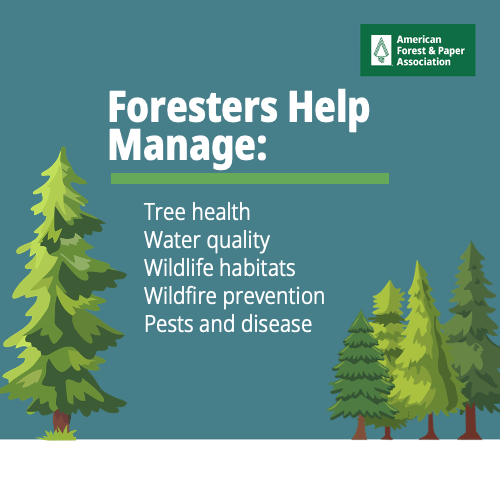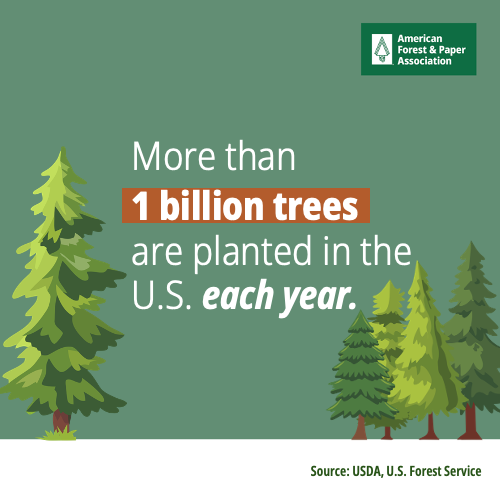What Are Forest Management Practices?
Registered Foresters from Across the U.S. Explain Sustainable Forest Management
Key Takeaways
This is part 2 of our forest management series. Explore part 1, “What is Sustainable Forestry” and part 3, "What is Biodiversity?" Foresters work closely with landowners to help manage their forests. Management practices help maintain a forest’s long-term health and growth.
Sustainable forestry means caring for and managing forests to ensure we have them now and for generations to come.
Foresters work closely with landowners to help manage their land for the long term. They use science, the best available technology and information to develop management plans.
Why is Forest Management Important?
Sustainable forest management helps maintain the health, biodiversity, productivity and longevity of a forest.
When developing management plans, foresters pay close attention to:
- Tree health
- Water quality
- Wildlife habitats
- Preventing wildfires
- Managing pests and disease
Foresters also work with landowners to identify and protect cultural and historic resources. These include things like historic artifacts or buildings and burial sites.
Sustainable forest management is important because it helps ensure there is balance in the ecosystem.

The Foresters Take:
Neal Carson, Timber and Forestry Manager, Packaging Corporation of America in Tennessee
"Sustainable forestry aims to maintain the long-term health and productivity of forests without depleting their resources."
Carolyn Mulligan, District Manager, American Forest Management in Virginia
"Sustainable forest management means we manage our forests in a way to ensure those forests can provide the planet with life’s essential things. Things like clean air and water, beautiful landscapes and diversity of species. Also the forest products that enhance our lives and provide us comfort."
Cierra L.S. Ward, Forestry Manager, Resource Management Services in North Carolina
"Sustainable forestry ensures that the cycle keeps happening again and again while protecting water quality, wildlife habitat, and the beauty of the forest."
What Are Examples of Sustainable Forest Management Practices?

Foresters and scientists use a variety of tactics to manage a forest. These practices help maintain a forest’s health and growth. They’re also one of the best ways to ensure the longevity of a forest.
Our expert foresters said forest management practices include:
- Reforestation and replanting
- Wildlife habitat creation and enhancement
- Managing for water quality
- Selective harvest
- Thinning
- Disease and pest management
- Fertilizing the soil
- Controlled burns, also called a prescribed fire
These practices have been used and refined over time to help maintain forest ecosystems.
On managed forests, trees are replanted to continue the cycle of growing. More than 1 billion seedlings are planted every year in the U.S. The majority of those are planted on managed forests.
The Foresters Take:
Neal Carson
"It includes measures like selective harvesting, where only mature trees are removed, leaving younger trees to grow and replenish the forest. Also reforestation efforts to replant trees in areas that have been harvested."
John F. McAlpine, President, Kingwood Forestry Services in Arkansas
"We are mimicking what mother nature does."
Carolyn Mulligan
"When replanting a site, foresters look at the characteristics of the land and soil. This is to determine the proper tree species, planting method and spacing to assure the greatest successes for survival and growth. Buffers are left along waterways to protect water quality."
Cierra L.S. Ward
"Sustainable forestry limits the number of acres that can be harvested. It also establishes guidelines and best practices for how to build forest roads, cross creeks, apply fertilizers and chemicals, and enhance wildlife habitat."
Foresters manage forests like you might manage a garden. Like weeding a garden, foresters do selective cuts or “thinnings” that remove dead, diseased, or otherwise troubled trees.
They also pull out underbrush that could catch fire to help prevent forest fires. This gives healthier trees the space and resources they need to thrive.
There are many reasons why trees are removed from forests, including:
- There’s not enough room for all the trees to grow.
- To provide a habitat for wildlife.
- To prevent forest fires.
- When more light needs to reach the forest floor.
- The trees are sick. They can get infected with diseases and insects, which can spread.
- A forester prescribed it for the long-term planning and health of a forest.
The Foresters Take:
Neal Carson
"Tree removal requires careful consideration to ensure that it is done sustainably and with minimal impact to the forest ecosystem."
John F. McAlpine
"Forest management reduces overstocking and improves tree health to be more resilient."
Carolyn Mulligan
"Sometimes trees grow too densely and compete with each other for water, light and nutrients. In cases like this, it is best to remove some of them."
Cierra L.S. Ward
"We remove trees at a thinning to open up the canopy, allowing more space, sunlight, water, and nutrients to be concentrated to the best trees."
Interested in Learning More About Sustainable Forestry?
Want to learn more about sustainable forest management in the U.S.? You can:
- Contact your state’s forestry association or Department of Forestry.
- Learn about the Sustainable Forestry and Land Retention Project
- Learn about International Paper’s work to enhance bird habitats in working forests.
